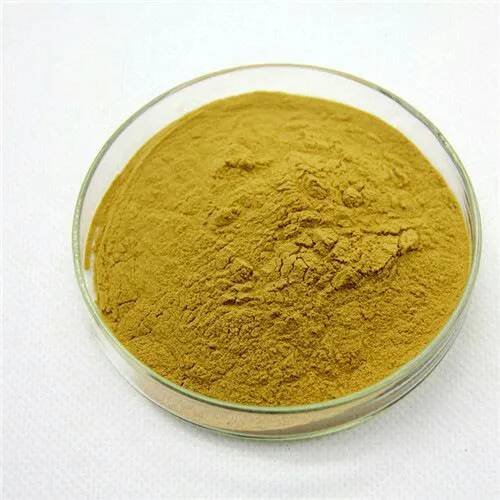- 0086-571-85302990
- sales@greenskybio.com
Optimal Bioavailability of Echinacea Extract.
2024-11-28

1. Introduction
Echinacea is a popular herbal remedy known for its potential immune - enhancing properties. However, the bioavailability of Echinacea Extract plays a vital role in determining whether these potential health benefits can be fully realized. Bioavailability refers to the proportion of a drug or supplement that enters the circulation and is available at the site of action. In the case of Echinacea Extract, understanding and optimizing its bioavailability is essential for its effective use in promoting health.

2. Factors Affecting Bioavailability of Echinacea Extract
2.1 Extraction Processes
Solvent - based extraction: Different solvents can be used to extract Echinacea. For example, ethanol - based extraction is commonly used. Ethanol can effectively dissolve many of the active compounds in Echinacea, such as alkamides and caffeic acid derivatives. However, the concentration of ethanol can influence the extraction efficiency and the resulting bioavailability. A higher concentration of ethanol may extract more of the lipophilic compounds, but it may also introduce impurities that could potentially affect bioavailability.
Supercritical fluid extraction: This method uses supercritical carbon dioxide as a solvent. It has several advantages over traditional solvent - based extraction. Supercritical carbon dioxide can selectively extract certain compounds, resulting in a purer extract. This can potentially lead to better bioavailability as there are fewer interfering substances. Moreover, it is a more environmentally friendly method as it does not leave behind toxic solvent residues.
2.2 Delivery Systems
Oral Delivery:
- Tablets and capsules are the most common forms of oral delivery for Echinacea extract. However, the bioavailability can be limited by factors such as poor dissolution in the gastrointestinal tract. The outer shell of some tablets may not break down easily, preventing the release of the extract. Capsules, on the other hand, may have better dissolution properties depending on the type of capsule used.
- Liquid formulations, such as tinctures or syrups, may offer better bioavailability in some cases. They can be more easily absorbed in the gastrointestinal tract compared to solid forms. However, they may also have a shorter shelf - life and require proper storage conditions.
Topical Delivery:
- When Echinacea extract is used topically, factors such as the penetration of the active compounds through the skin become important. The formulation of topical products, such as creams or gels, can influence the bioavailability. A well - formulated cream with appropriate emulsifiers and penetration enhancers can help the active compounds in Echinacea extract to penetrate the skin more effectively.
- Another aspect to consider in topical delivery is the stability of the extract. Some active compounds in Echinacea may be sensitive to light or air, and the formulation should be designed to protect these compounds during storage and application.
2.3 Compatibility with Other Components
Combination with Vitamins: When Echinacea extract is combined with certain vitamins, it may affect its bioavailability. For example, vitamin C is known to have antioxidant properties. When combined with Echinacea, it may enhance the stability of the active compounds in the extract. This could potentially lead to better bioavailability as the active compounds are less likely to be degraded before they are absorbed.
Interaction with Minerals: Minerals can also interact with Echinacea extract. For instance, calcium may form complexes with some of the active compounds in Echinacea, which could either enhance or reduce their bioavailability depending on the nature of the complex. Understanding these interactions is crucial for formulating products that contain both Echinacea extract and minerals.

3. Strategies to Optimize Bioavailability
3.1 Improving Extraction Techniques
Optimizing Solvent Selection: Research should be carried out to determine the optimal solvent concentration and type for extracting Echinacea. For example, a combination of solvents may be used to extract a wider range of active compounds with high bioavailability. By carefully selecting the solvents, it is possible to increase the amount of bioavailable compounds in the extract.
Using Novel Extraction Technologies: In addition to supercritical fluid extraction, other emerging technologies such as microwave - assisted extraction could be explored. Microwave - assisted extraction can reduce the extraction time and potentially increase the extraction yield of bioactive compounds. This could lead to an extract with higher bioavailability.
3.2 Enhancing Delivery Systems
Formulation Optimization for Oral Delivery: For tablets and capsules, formulators can use techniques such as coating with materials that improve dissolution in the gastrointestinal tract. For liquid formulations, adding substances that enhance absorption, such as surfactants, can be considered. Additionally, the pH of the formulation can be adjusted to match the optimal absorption conditions in the gut.
Improving Topical Delivery: To enhance the bioavailability of Echinacea extract in topical products, research can focus on developing new penetration enhancers. These enhancers can be natural or synthetic substances that help the active compounds cross the skin barrier more efficiently. Also, improving the packaging of topical products to protect the extract from environmental factors can increase its stability and bioavailability.
3.3 Understanding and Managing Component Interactions
Studying the Effects of Combinations: More research should be conducted on the combinations of Echinacea extract with vitamins, minerals, and other herbal extracts. By understanding the interactions between these components, it is possible to formulate products that optimize the bioavailability of Echinacea. For example, if a certain vitamin is found to enhance the bioavailability of Echinacea, it can be included in the formulation in an appropriate amount.
Adjusting Formulations Based on Interactions: Once the interactions are understood, formulations can be adjusted accordingly. If a mineral is found to reduce the bioavailability of Echinacea, either the amount of the mineral can be reduced or a different form of the mineral that does not interact negatively can be used.

4. Conclusion
Optimizing the bioavailability of Echinacea extract is a complex but important task. By considering factors such as extraction processes, delivery systems, and compatibility with other components, it is possible to develop products that maximize the potential health benefits of Echinacea. Continued research in these areas will lead to a better understanding of how to achieve optimal bioavailability of Echinacea extract, which will ultimately benefit consumers who use Echinacea - based products for health promotion.

FAQ:
What are the main factors affecting the bioavailability of Echinacea extract?
The main factors include the extraction process, delivery systems, and compatibility with other components. Different extraction processes can result in different compositions and forms of the extract, which may influence how well it is absorbed in the body. Delivery systems, such as capsules or tablets, can also play a role in determining bioavailability. Compatibility with other components, for example, when combined with certain substances, may enhance or reduce its absorption.
How does the extraction process impact the bioavailability of Echinacea extract?
The extraction process determines the chemical composition and physical form of the Echinacea extract. If the extraction method is not optimal, it may lead to the presence of impurities or the destruction of active components. For example, some extraction techniques might cause denaturation of proteins or degradation of bioactive compounds. A well - designed extraction process can ensure that the key active ingredients are obtained in a form that is more easily absorbed by the body, thus increasing bioavailability.
What role do delivery systems play in the bioavailability of Echinacea extract?
Delivery systems are important for the bioavailability of Echinacea extract. For example, if it is in a capsule form, the capsule material needs to be able to dissolve properly in the digestive system to release the extract. Tablets may have different disintegration times and release profiles. Some delivery systems can protect the extract from degradation in the stomach before it reaches the intestines, where absorption mainly occurs. Also, certain delivery systems can be designed to target specific areas in the body for better absorption.
Can compatibility with other components enhance the bioavailability of Echinacea extract?
Yes, compatibility with other components can enhance the bioavailability of Echinacea extract. Some substances can act as absorption enhancers when combined with Echinacea extract. For instance, certain vitamins or minerals may interact with the active ingredients in the extract in a way that improves its solubility or transport across cell membranes. However, some combinations may also lead to decreased bioavailability if there are negative interactions, such as chemical reactions that inactivate the active components.
How can one ensure the optimal bioavailability of Echinacea extract in practice?
To ensure optimal bioavailability in practice, one should choose products with reliable extraction processes. Look for products that use advanced extraction techniques to preserve the active components. Consider the delivery system and choose one that is suitable for your needs, for example, if you have digestive problems, a more easily digestible delivery system may be better. Also, be aware of the potential interactions with other components if you are taking other supplements or medications simultaneously. Consulting a healthcare professional can also be helpful.
Related literature
- Bioavailability of Echinacea Extract: A Comprehensive Review"
- "Enhancing the Bioavailability of Echinacea: New Approaches in Extraction and Delivery"
- "The Impact of Component Compatibility on Echinacea Extract Bioavailability"
- ▶ Hesperidin
- ▶ citrus bioflavonoids
- ▶ plant extract
- ▶ lycopene
- ▶ Diosmin
- ▶ Grape seed extract
- ▶ Sea buckthorn Juice Powder
- ▶ Beetroot powder
- ▶ Hops Extract
- ▶ Artichoke Extract
- ▶ Reishi mushroom extract
- ▶ Astaxanthin
- ▶ Green Tea Extract
- ▶ Curcumin Extract
- ▶ Horse Chestnut Extract
- ▶ Other Problems
- ▶ Boswellia Serrata Extract
- ▶ Resveratrol Extract
- ▶ Marigold Extract
- ▶ Grape Leaf Extract
- ▶ blog3
- ▶ blog4
-
The best bitter gourd extract in 2024.
2024-11-28
-
The best baicalin in nature.
2024-11-28
-
Chinese lily extract manufacturers.
2024-11-28
-
Nature's best β - carotene.
2024-11-28
-
Standard - process Coenzyme Q10.
2024-11-28
-
Bulk purchase of pomegranate extract.
2024-11-28
-
Extraction process of bilberry extract.
2024-11-28
-
Maitake Mushroom Extract
2024-11-28
-
Soy Extract
2024-11-28
-
Europen Bilberry Extract
2024-11-28
-
Coconut Water Powder
2024-11-28
-
Elderberry Extract
2024-11-28
-
Tinospora cordifolia extract
2024-11-28
-
Baicalin
2024-11-28
-
Beetroot juice Powder
2024-11-28
-
Troxerutin
2024-11-28
-
Centella Asiatica Extract
2024-11-28





















